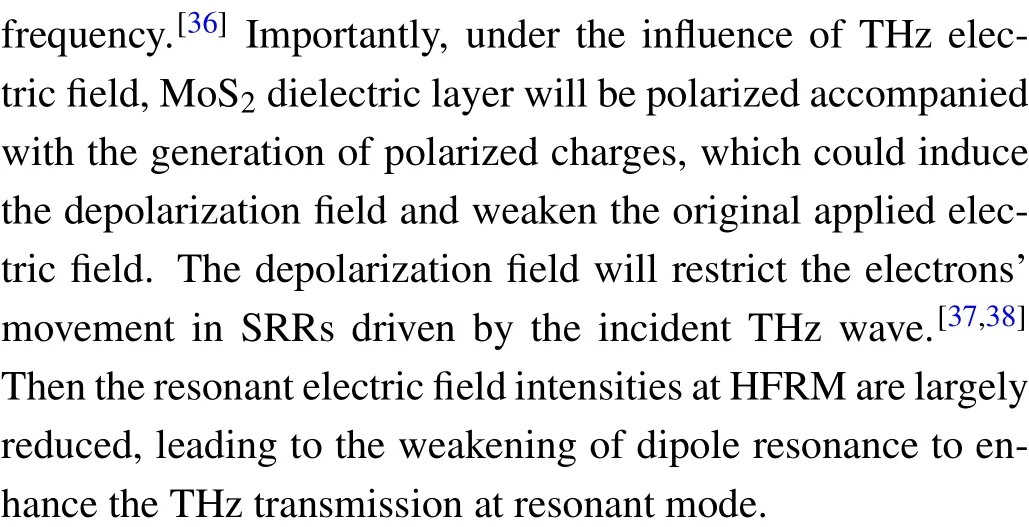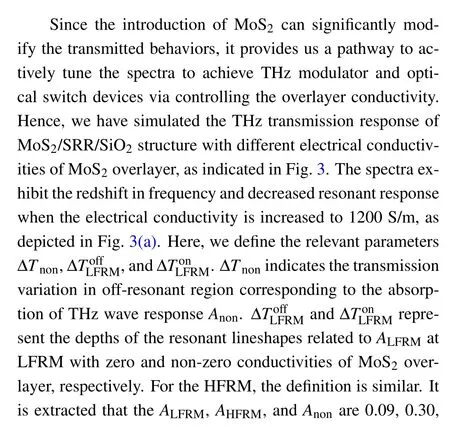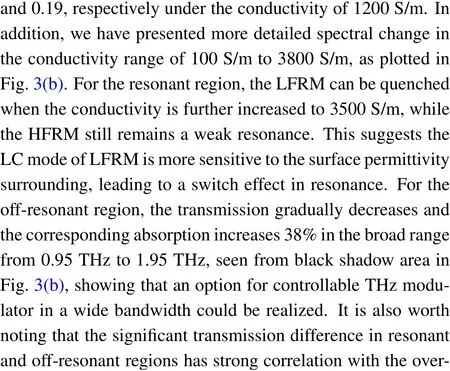Tunable terahertz transmission behaviors and coupling mechanism in hybrid MoS2 metamaterials
Yuwang Deng(鄧雨旺), Qingli Zhou(周慶莉), Wanlin Liang(梁菀琳),Pujing Zhang(張樸婧), and Cunlin Zhang(張存林)
Key Laboratory of Terahertz Optoelectronics,Ministry of Education,and Beijing Advanced Innovation Center for Imaging Theory and Technology,Department of Physics,Capital Normal University,Beijing 100048,China
Keywords: terahertz metamaterial,MoS2,coupling mechanism,switchable device
1. Introduction
The transition metal dichalcogenides have earned extensive attention in recent years due to the potential application for novel semiconductor devices. This family of compounds displays abundant electronic properties ranging from semiconductor, semimetal, metal, and even to superconductor depending on the choice of transition metal,[1]one of which is MoS2with outstanding optical and electronic properties.[2-4]The bulk MoS2crystal is an indirect bandgap semiconductor but it can be transformed into a direct semiconductor in the monolayer limit, which makes it attractive for photoluminescent applications.[5]After the established synthesis and fabrication strategies, MoS2has been employed in field effect transistors,[6]integrated circuits,[7]optoelectronic devices,[8,9]light generation and harvesting,[10-13]valleytronics,[14]van der Waals heterostructures,[15,16]and mimic synaptics.[17]
Metamaterials are the artificially structured composite arrays of subwavelength structures.Their extraordinary physical properties cannot be obtained in natural materials,such as negative refractive index,[18,19]sub-diffraction imaging,[2]perfect absorption,[21]and electromagnetic cloaking.[22,23]Those special properties originate from electromagnetic interaction between incident radiation and those man-made structures.[24-26]Especially, the MoS2-metamaterial integrated devices have been exploited to manipulate electromagnetic resonant behaviors combined with the excellent properties of MoS2layer and the novel functionalities of metamaterials.[9,27]Such hybrid structures with optically controlled conductivity of MoS2can realize tunable sharp Fano resonances and tailored plasmoninduced transparency in the THz range. Few studies have been carried out to explore the influence of MoS2on other resonance modes,as well as the coupling mechanism between MoS2layer and metamaterial. Split ring resonantor (SRR)as a classical metamaterial structure, which has both electrical and magnetic responses with two different resonance modes defined as inductance-capacitance(LC)resonance and dipole resonance,[28,29]has become the basic building block for intensive research of THz metamaterials and other hybrid metaphotonic devices. Those studies have successfully illustrated the manipulation of slow light,[30]ultrafast all-optical switch,[31]dynamical resonance frequency shift,[32]and controllable all-optical modulation speed.[33,34]It is obvious that the SRR is a fundamental and important structural unit to further develop and expand the THz device functions.
Here,we have proposed the hybrid MoS2/SRR structures to investigate the overlayer induced change and optical control in transmission spectra from the simulated and theoretical calculations. Compared with the other two substrates, we have found the remarkable change with large red-shift at resonant frequencies and broad bandpass in non-resonant region after covering the MoS2layer onto SRR with SiO2substrate.The simulated results have proved the introduction of MoS2could significantly engineer the transmitted spectra due to depolarization field effect verified by the simulated electric field distributions. In addition,a 38%broad band modulation from 0.95 THz to 1.95 THz and 100%modulation of the resonances with a switchable effect can be achieved via tuning conductivity of the MoS2overlayer. It is worth noting that the LC resonance is more easily tailored than the dipole resonance with the varied conductivity of MoS2. We have further utilized the coupled Lorentz oscillator model to theoretically calculate the influence of MoS2on the THz response spectra accompanied with resonance red-shift,bandwidth broadening,and intensity change, which originate from the coupling and damping between MoS2overlayer and SRR structure. Our results imply that the conductivity-engineered switchable device and controllable broad band THz modulator could be implemented through hybrid MoS2metastructures.
2. Simulated results and theoretical discussion

Fig.2. THz transmission of SRR and MoS2/SRR hybrid structures on semiconductor(a)and SiO2 (b)substrates,respectively. The simulated surface currents(c)and electric field distributions(d)of SRR/SiO2 without and with MoS2 overlayer at LFRM and HFRM.
For exploring the resonant behaviors of our proposed hybrid MoS2metamaterial, numerical calculations are performed based on the finite integration method with the periodic boundary conditions. The schematic structure and the unit cell of the hybrid MoS2/SRR structure are depicted in Fig.1 with three layers including MoS2layer,gold arrays,and substrate. In our simulation, the thickness of Au is 200 nm and the substrate is 250μm. A MoS2layer with the thickness of 400 nm is covered on SRR structure surface. The periodic length is 50 μm in bothxandydirections. The THz wave polarizing alongxaxis is normally incident to the structure surface,as shown in Fig.1(a). Here,GaAs,Si,and SiO2with dielectric constants of 12.9,11.56,and 3.75,respectively,are used as substrates, and Au(lossy metal)with conductivity of 3.56×107S/m is considered to form the metallic SRR array.The permittivity of MoS2is set to be 12.25.[9]

Fig. 1. (a) Illustration of the MoS2/SRR structure with incident THz wave.(b)The schematic diagram of unit cell of the SRR highlighting the structural dimensions. The top-right insert is the cross-section of the unit cell.
As plotted in Fig. 2(a), when the polarization of the incident THz wave is parallel to the gap-bearing side of SRR,the THz transmission responses of SRR without and with MoS2exhibit remarkable spectral variations. The transmission spectra of SRR structure on Si and GaAs substrates reveal two resonant responses,corresponding to low frequency resonant mode (LFRM) at~0.59 (Si substrate) and~0.56 THz(GaAs substrate),and high frequency resonant mode(HFRM)at~1.67(Si substrate)and~1.58 THz(GaAs substrate),respectively. In addition, there is a broad transmission window of 0.75 THz in non-resonant region lying between the above two resonances. When the SRR metamaterials are covered with MoS2, the spectral responses can be modulated significantly. The transmission of LFRM and HFRM is slightly increased in resonant region and decreased in off-resonant region. The red-shift frequencies of LFRM and HFRM are also clearly and quantitatively recorded in Table 1. It is evident that the optical properties of metastructures on Si and GaAs substrates are similar in the THz region.
Then we further choose SiO2substrate,which has a large difference in dielectric constant compared with the above two substrates,to study the influence of the dielectric environment on the SRR arrays. The simulated results are presented in Fig.2(b)for the SRR/SiO2structure. Without and with the introduction of MoS2overlayer,the THz transmission variation and resonant frequency shift of LFRM and HFRM are illustrated in Table 1. Additionally,a broadening of resonant lineshape can be observed, corresponding to values of full width at half maximum (FWHM) from 0.11 THz to 0.13 THz for LFRM, and 0.21 THz to 0.30 THz for HFRM, respectively.In the off-resonant regions, as shown in the black shadow,the bandwidth of the transmission window is much broader than that in Fig.2(a),showing 1.47 THz without overlayer and 1.11 THz with MoS2,respectively. Based on the above observations, it can be concluded that the THz response variation of SRR/SiO2without and with MoS2overlayer is more sensitive than those on Si and GaAs substrates, accompanied with large transmission change and frequency red-shift in resonant region, and wider transmission bandwidth in off-resonant region. Our obtained results also indicate the overlayer material has the ability to tune the THz spectral responses via changing the surrounding dielectric environments.

Table 1. THz transmission and resonant frequency shift of LFRM and HFRM without and with MoS2 overlayer.


3. Tunable transmission behaviors



Fig.3. (a)and(b)Simulated amplitude transmission spectra with different electrical conductivities of MoS2 overlayer and the definition of the parameters of ΔT non,ΔToffLFRM,and ΔTonLFRM. (c)and(d)Simulated electric field distributions in the hybrid metamaterial at LFRM and HFRM,respectively.



The modulation depth of HFRM is similar. We have found that the modulation depth can be tuned to 90% at HFRM. For LFRM, this modulation is much higher and can achieve 100% by increasing the conductivity to 3500 S/m,which infers the occurrence of a switchable resonant behaviour. This effect could serve as a tunable MoS2-based switch device when the conductivity of MoS2is tuned under the external field. It is evident that the tunable THz behaviors strongly depend on the properties of MoS2layer. Hence,we further discuss the influence of its thickness on the amplitude transmission. Our simulated results exhibit the remarkable red-shift of LFRM and HFRM with the increased thickness. The resonant intensity is reduced slightly at LFRM and nearly unchanged at HFRM. Additionally, the bandwidth of the off-resonant region has a narrowing trend(not shown).

Fig.4. (a)Extracted THz absorption response of the hybrid structure with different overlayer conductivities. Influence of the overlayer conductivity on the resonant frequency shift(b),bandwidth of resonant regions(c),and modulation depth(d)for LFRM and HFRM,respectively.The solid lines are the fitting curves.
4. Theoretical coupling mechanism
For better understanding these phenomena and explaining the coupling mechanism in the hybrid metamaterial,a Lorentz coupling model[35,36,39]is used to explain the variations in transmission spectra and quantitatively reveal the interaction between MoS2and SRR in THz region. This coupling model can be expressed as

Then the THz response intensity of metamaterial without and with the MoS2overlayer can be obtained by plotting the curve of|C1|, as depicted in Figs.5(a)and 5(b)under the initial values ofγ1=0.025,ω1=1.0,a1=2.0,γ2=0.01,ω2=1.3,a2=1.1, andυ12=0.5. Notably, the variation of THz response intensity in resonant region is consistent with the simulated observation of THz transmission of SRR structure without and with MoS2overlayer illustrated in Fig.2(b),showing a red-shift accompanied with the reduction in resonant absorption and broadening in bandwidth. To understand the influence of the coupling and damping of MoS2on metamaterials, we further modify the parametersυ12andγ2, as shown in Figs.5(c)and 5(d),respectively,while keeping other parameters constant. It is evident thatυ12determines both frequency shift and the intensity of the resonance, showing the stronger coupling leads to the larger red-shift and lower peak intensity. Damping rateγ2as an important parameter mainly affects the shape as well as the bandwidth of the resonance with the higher damping for broader spectral response.
In Fig.6(a),further calculations suggest that the THz response peak intensity is exponential decay with theυ12(black triangles). However, the THz intensity in off-resonant region is exponential growth with theυ12(blue dots).The red squares and its fitting curve show the linear dependency between the red-shift frequency and coupling strength. Similar to the influence ofυ12,the THz response intensity in the resonant region also exhibits exponential decay withγ2,as shown in Fig.6(b).In addition, the linear increasing of resonant bandwidth withγ2is illustrated by FWHM. It is worth highlighting that the above observed tendency agrees well with the simulated results depicted in Fig. 4, implying a stronger coupling effect with higherυ12will occur in the hybrid structure with the increased electrical conductivity. Moreover, this effect will result in large frequency red-shift and transmission change in THz resonant and off-resonant regions. The identical linear increasing of FWHM with overlayer conductivity in Fig.4(c)and with the damping rate in Fig.6(b)suggests thatγ2is highly related to the conductivity of MoS2overlayer, which means the THz transmission loss of MoS2coating layer will increase with increasing conductivity. The obtained results could help to further reveal the interaction between MoS2and metamaterials.

Fig.5. Panels(a)and(b)are the THz response intensity of the uncoupled SRR and coupled MoS2/SRR system. Panels(c)and(d)are the THz response intensity of MoS2/SRR system under the different coupling coefficients υ12 and damping rates γ2,while keeping other parameters constant.

Fig.6. (a)Influence of υ12 on THz response intensity in resonant region(black triangles)and off-resonant region(blue dots). The curves are the exponential fitting. Influence of υ12 on frequency red-shift(red squares). The curve is the linear fitting. (b)Influence of γ2 on THz response intensity and bandwidth.
5. Conclusion
In summary, we propose a hybrid structure composed of MoS2layer and SRR arrays on different substrates to efficiently control THz wave. The simulated results indicate that the hybrid MoS2/SRR/SiO2is more susceptible to THz field,showing large frequency red-shift and bandwidth broadening.Our studies also elucidate that the top cover MoS2layer with varied conductivity could distinctly manipulate the THz response. Specifically, this hybrid structure can realize a 38%wide-band modulator in off-resonant region,90%modulation of dipole resonance, and 100% modulation depth of LC resonance with a switch effect. In addition, a Lorentz coupling model is employed to theoretically investigate the influence of MoS2on the THz response spectra and the coupling interaction between MoS2overlayer and SRR structure. We find the characteristics of conductivity-induced changes in transmission spectra with frequency red-shift,bandwidth broadening, and variation of THz response intensity mainly originate from the coupling and damping between MoS2overlayer and the SRR arrays. Our work will provide an option for tunable THz modulators,switchable devices and other THz functional components for THz wave manipulation based on MoS2material.
Acknowledgements
Project supported by Beijing Natural Science Foundation of China (Grant No. 4181001) and the National Natural Science Foundation of China (Grant Nos. 62075142 and 61875140).
- Chinese Physics B的其它文章
- Role of compositional changes on thermal,magnetic,and mechanical properties of Fe–P–C-based amorphous alloys
- Substrate tuned reconstructed polymerization of naphthalocyanine on Ag(110)
- Anti-PT-symmetric Kerr gyroscope
- Information flow between stock markets:A Koopman decomposition approach
- Cascading failures of overload behaviors using a new coupled network model between edges
- High efficiency ETM-free perovskite cell composed of CuSCN and increasing gradient CH3NH3PbI3

